Dissertation: Impact of Healthcare Worker Behavior on Patient Outcomes
VerifiedAdded on 2020/05/08
|37
|11046
|124
Dissertation
AI Summary
This dissertation presents a systematic review investigating the impact of healthcare worker behavior on patient outcomes. The study focuses on the behaviors of healthcare professionals, including communication skills, patient dignity, and leadership, and how these behaviors affect patient well-being and length of stay. The research examines the challenges faced in healthcare settings, such as inappropriate behavior, negative attitudes, and the influence of organizational factors. The methodology includes a literature search using keywords like 'healthcare professionals' and 'patient outcomes' across databases like Medline and Psych Info. Inclusion and exclusion criteria are defined to refine the scope of the review, focusing on primary and secondary research published between 2012 and 2018 in English. The dissertation aims to identify factors contributing to negative behaviors, explore their effects on patients, and recommend strategies for improvement. The research questions address the reasons behind negative attitudes, their impacts, and existing interventions to overcome challenging behaviors. The study's hypotheses examine the influence of factors like long working hours, lack of training, and patient-related issues on healthcare worker behavior and patient well-being. The dissertation is a valuable resource for understanding the complex interplay between healthcare worker behavior and patient outcomes.
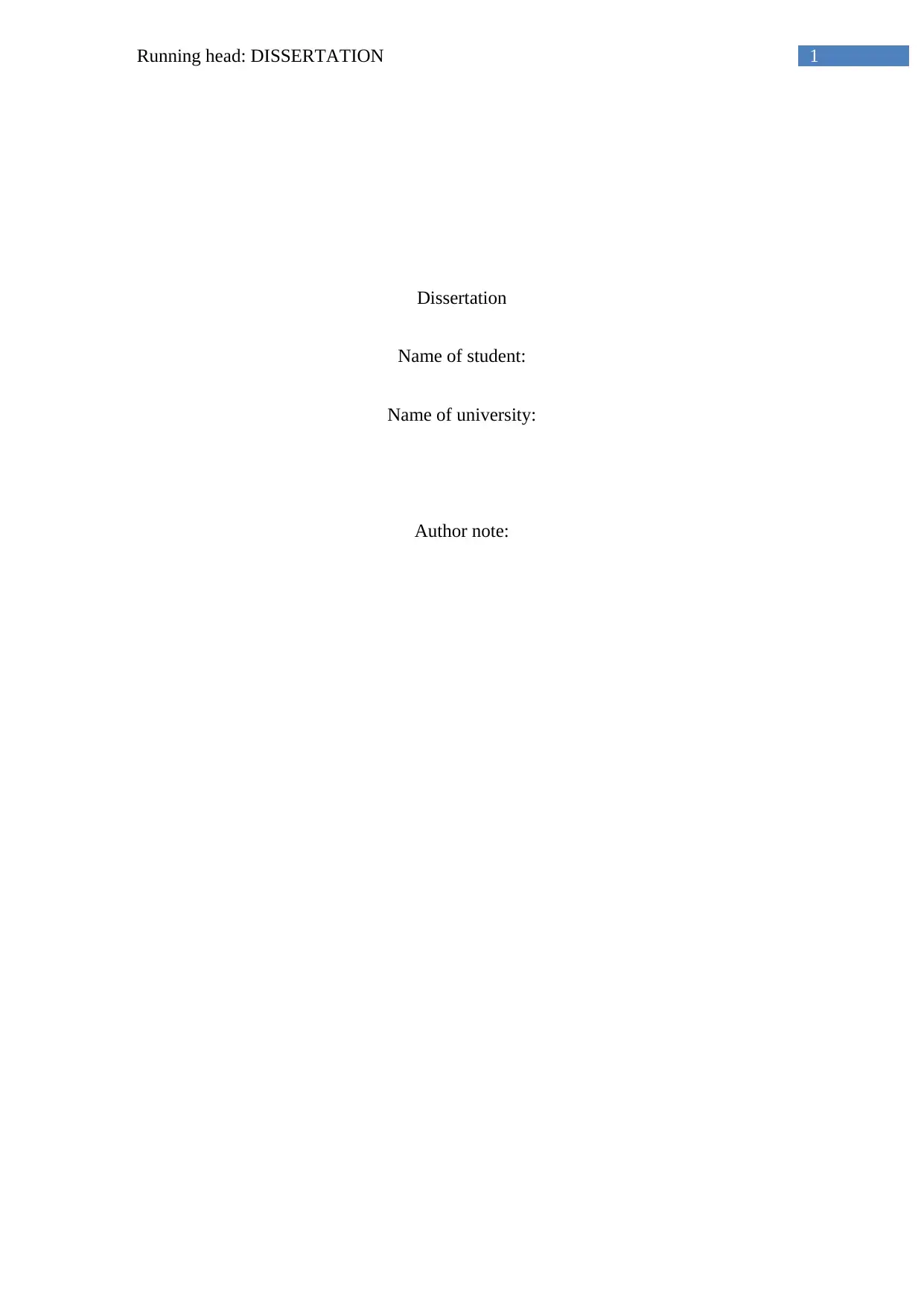
1Running head: DISSERTATION
Dissertation
Name of student:
Name of university:
Author note:
Dissertation
Name of student:
Name of university:
Author note:
Paraphrase This Document
Need a fresh take? Get an instant paraphrase of this document with our AI Paraphraser
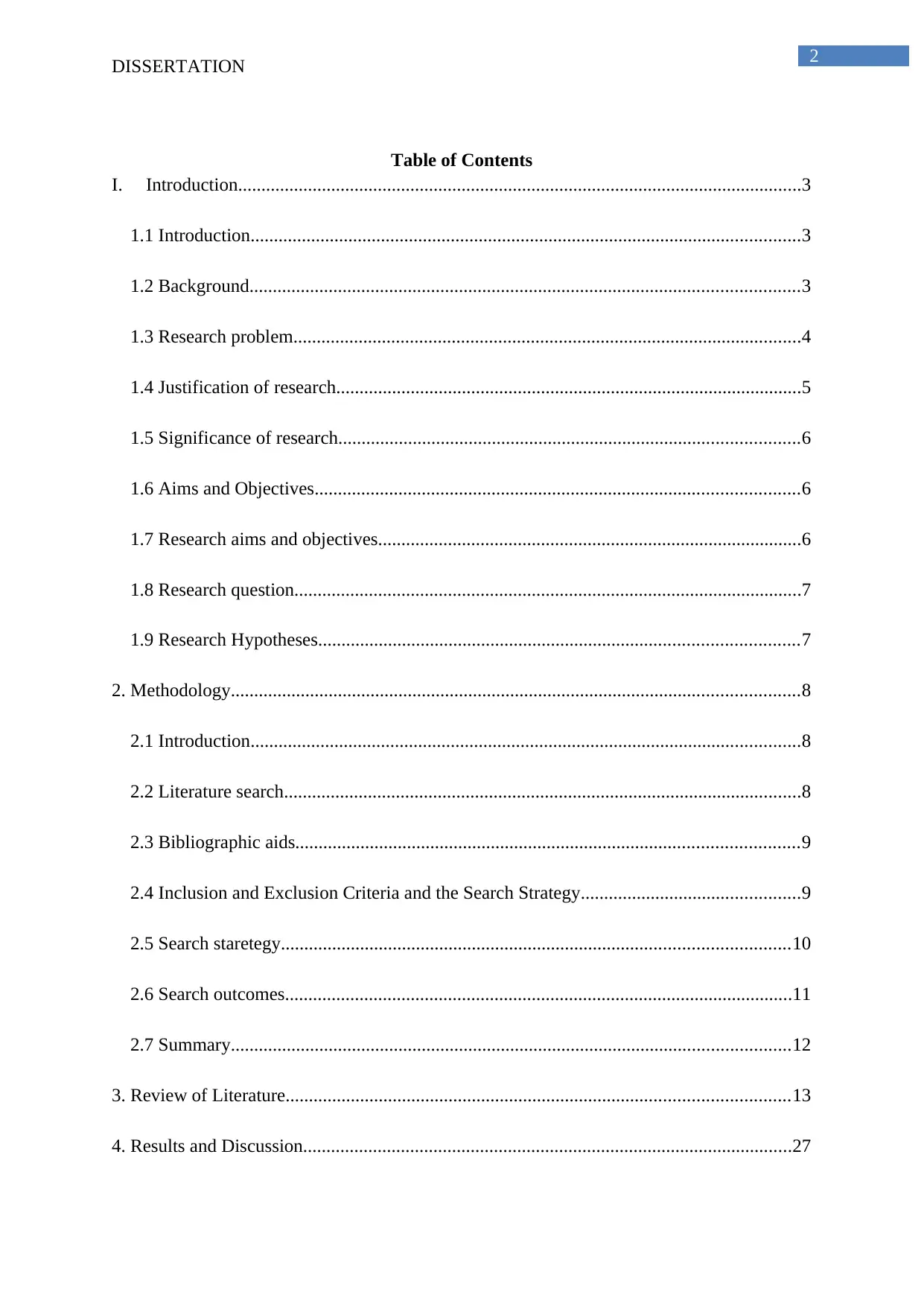
2
DISSERTATION
Table of Contents
I. Introduction.........................................................................................................................3
1.1 Introduction......................................................................................................................3
1.2 Background......................................................................................................................3
1.3 Research problem.............................................................................................................4
1.4 Justification of research....................................................................................................5
1.5 Significance of research...................................................................................................6
1.6 Aims and Objectives........................................................................................................6
1.7 Research aims and objectives...........................................................................................6
1.8 Research question.............................................................................................................7
1.9 Research Hypotheses.......................................................................................................7
2. Methodology..........................................................................................................................8
2.1 Introduction......................................................................................................................8
2.2 Literature search...............................................................................................................8
2.3 Bibliographic aids............................................................................................................9
2.4 Inclusion and Exclusion Criteria and the Search Strategy...............................................9
2.5 Search staretegy.............................................................................................................10
2.6 Search outcomes.............................................................................................................11
2.7 Summary........................................................................................................................12
3. Review of Literature............................................................................................................13
4. Results and Discussion.........................................................................................................27
DISSERTATION
Table of Contents
I. Introduction.........................................................................................................................3
1.1 Introduction......................................................................................................................3
1.2 Background......................................................................................................................3
1.3 Research problem.............................................................................................................4
1.4 Justification of research....................................................................................................5
1.5 Significance of research...................................................................................................6
1.6 Aims and Objectives........................................................................................................6
1.7 Research aims and objectives...........................................................................................6
1.8 Research question.............................................................................................................7
1.9 Research Hypotheses.......................................................................................................7
2. Methodology..........................................................................................................................8
2.1 Introduction......................................................................................................................8
2.2 Literature search...............................................................................................................8
2.3 Bibliographic aids............................................................................................................9
2.4 Inclusion and Exclusion Criteria and the Search Strategy...............................................9
2.5 Search staretegy.............................................................................................................10
2.6 Search outcomes.............................................................................................................11
2.7 Summary........................................................................................................................12
3. Review of Literature............................................................................................................13
4. Results and Discussion.........................................................................................................27
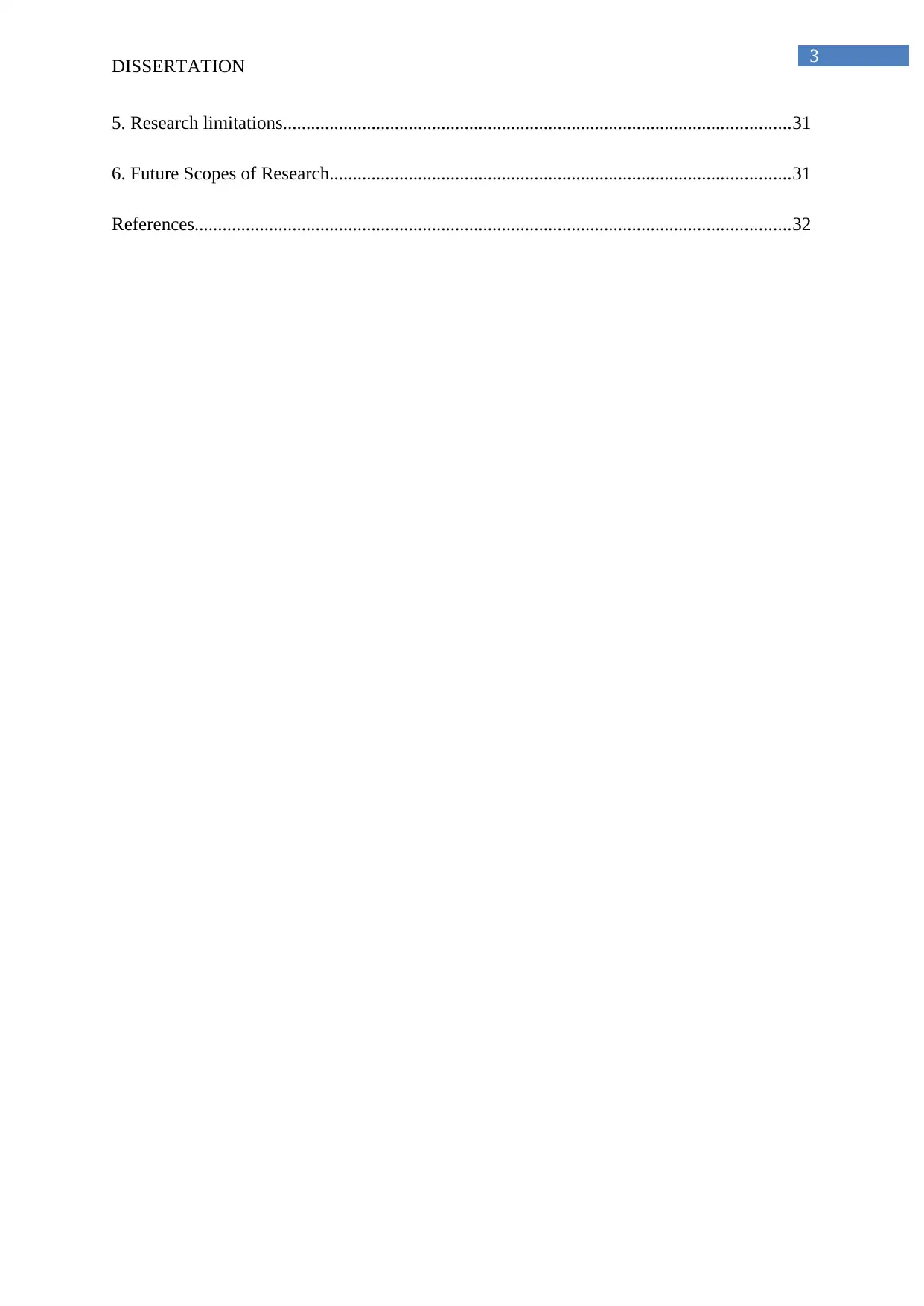
3
DISSERTATION
5. Research limitations.............................................................................................................31
6. Future Scopes of Research...................................................................................................31
References................................................................................................................................32
DISSERTATION
5. Research limitations.............................................................................................................31
6. Future Scopes of Research...................................................................................................31
References................................................................................................................................32
⊘ This is a preview!⊘
Do you want full access?
Subscribe today to unlock all pages.

Trusted by 1+ million students worldwide
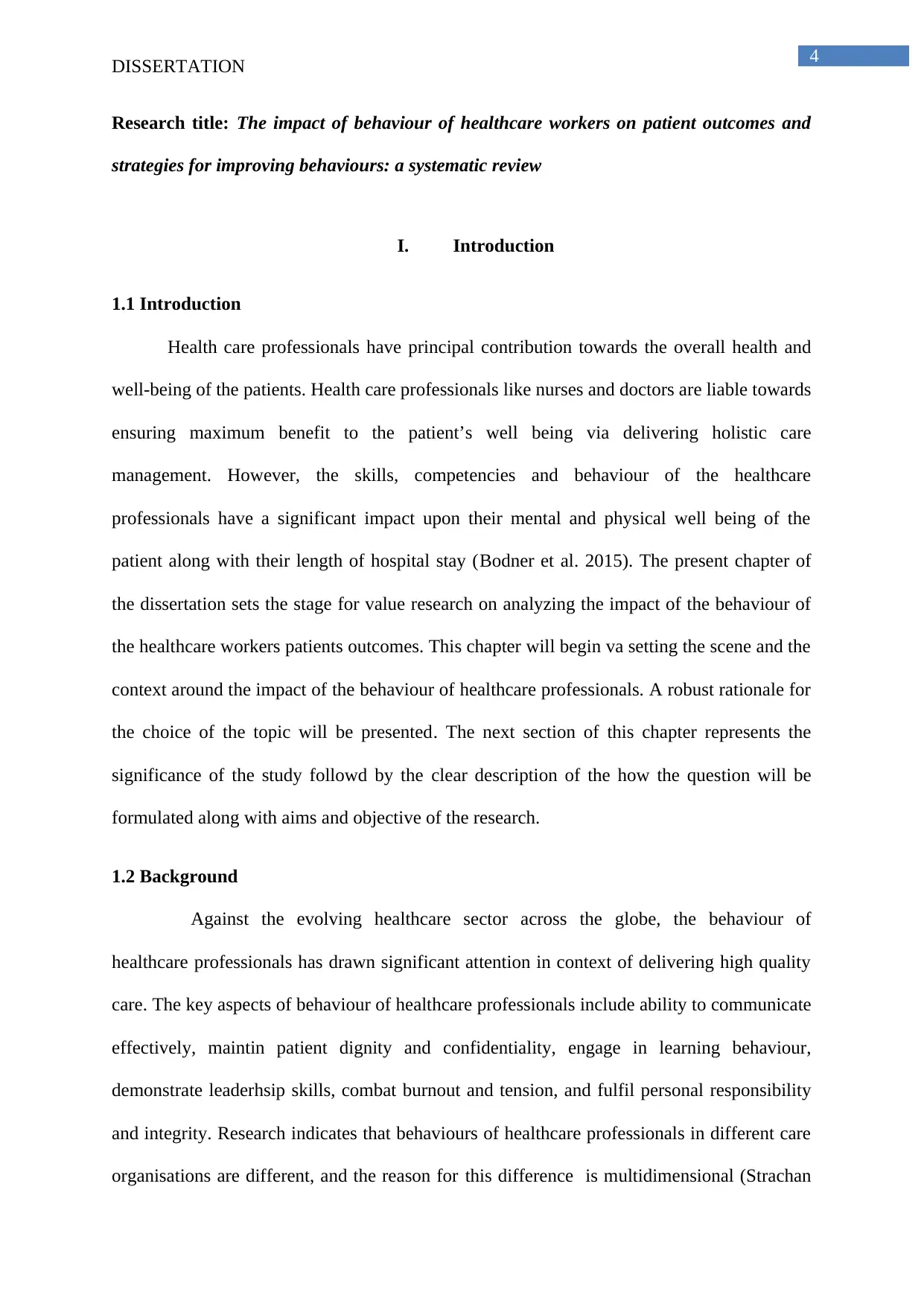
4
DISSERTATION
Research title: The impact of behaviour of healthcare workers on patient outcomes and
strategies for improving behaviours: a systematic review
I. Introduction
1.1 Introduction
Health care professionals have principal contribution towards the overall health and
well-being of the patients. Health care professionals like nurses and doctors are liable towards
ensuring maximum benefit to the patient’s well being via delivering holistic care
management. However, the skills, competencies and behaviour of the healthcare
professionals have a significant impact upon their mental and physical well being of the
patient along with their length of hospital stay (Bodner et al. 2015). The present chapter of
the dissertation sets the stage for value research on analyzing the impact of the behaviour of
the healthcare workers patients outcomes. This chapter will begin va setting the scene and the
context around the impact of the behaviour of healthcare professionals. A robust rationale for
the choice of the topic will be presented. The next section of this chapter represents the
significance of the study followd by the clear description of the how the question will be
formulated along with aims and objective of the research.
1.2 Background
Against the evolving healthcare sector across the globe, the behaviour of
healthcare professionals has drawn significant attention in context of delivering high quality
care. The key aspects of behaviour of healthcare professionals include ability to communicate
effectively, maintin patient dignity and confidentiality, engage in learning behaviour,
demonstrate leaderhsip skills, combat burnout and tension, and fulfil personal responsibility
and integrity. Research indicates that behaviours of healthcare professionals in different care
organisations are different, and the reason for this difference is multidimensional (Strachan
DISSERTATION
Research title: The impact of behaviour of healthcare workers on patient outcomes and
strategies for improving behaviours: a systematic review
I. Introduction
1.1 Introduction
Health care professionals have principal contribution towards the overall health and
well-being of the patients. Health care professionals like nurses and doctors are liable towards
ensuring maximum benefit to the patient’s well being via delivering holistic care
management. However, the skills, competencies and behaviour of the healthcare
professionals have a significant impact upon their mental and physical well being of the
patient along with their length of hospital stay (Bodner et al. 2015). The present chapter of
the dissertation sets the stage for value research on analyzing the impact of the behaviour of
the healthcare workers patients outcomes. This chapter will begin va setting the scene and the
context around the impact of the behaviour of healthcare professionals. A robust rationale for
the choice of the topic will be presented. The next section of this chapter represents the
significance of the study followd by the clear description of the how the question will be
formulated along with aims and objective of the research.
1.2 Background
Against the evolving healthcare sector across the globe, the behaviour of
healthcare professionals has drawn significant attention in context of delivering high quality
care. The key aspects of behaviour of healthcare professionals include ability to communicate
effectively, maintin patient dignity and confidentiality, engage in learning behaviour,
demonstrate leaderhsip skills, combat burnout and tension, and fulfil personal responsibility
and integrity. Research indicates that behaviours of healthcare professionals in different care
organisations are different, and the reason for this difference is multidimensional (Strachan
Paraphrase This Document
Need a fresh take? Get an instant paraphrase of this document with our AI Paraphraser
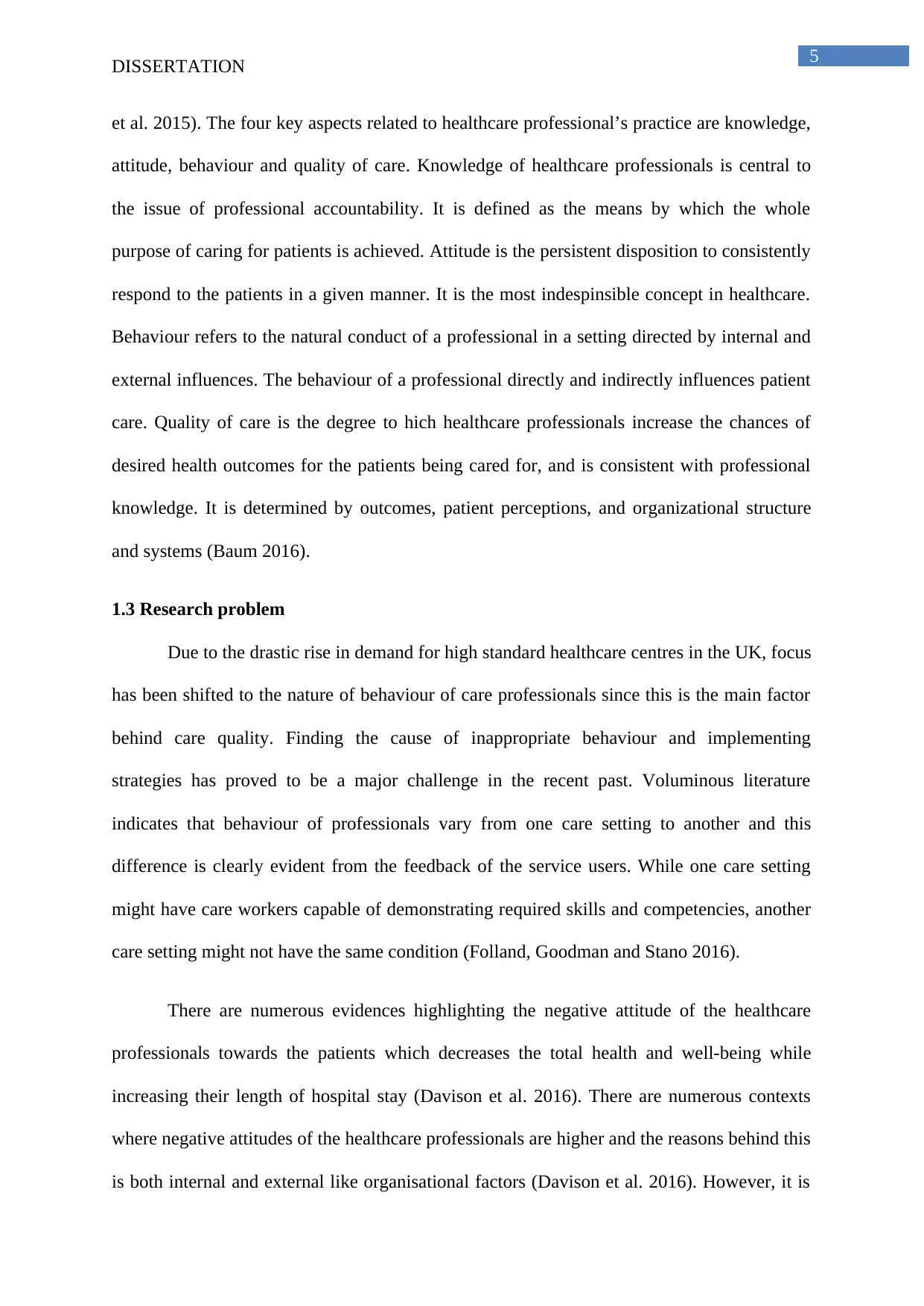
5
DISSERTATION
et al. 2015). The four key aspects related to healthcare professional’s practice are knowledge,
attitude, behaviour and quality of care. Knowledge of healthcare professionals is central to
the issue of professional accountability. It is defined as the means by which the whole
purpose of caring for patients is achieved. Attitude is the persistent disposition to consistently
respond to the patients in a given manner. It is the most indespinsible concept in healthcare.
Behaviour refers to the natural conduct of a professional in a setting directed by internal and
external influences. The behaviour of a professional directly and indirectly influences patient
care. Quality of care is the degree to hich healthcare professionals increase the chances of
desired health outcomes for the patients being cared for, and is consistent with professional
knowledge. It is determined by outcomes, patient perceptions, and organizational structure
and systems (Baum 2016).
1.3 Research problem
Due to the drastic rise in demand for high standard healthcare centres in the UK, focus
has been shifted to the nature of behaviour of care professionals since this is the main factor
behind care quality. Finding the cause of inappropriate behaviour and implementing
strategies has proved to be a major challenge in the recent past. Voluminous literature
indicates that behaviour of professionals vary from one care setting to another and this
difference is clearly evident from the feedback of the service users. While one care setting
might have care workers capable of demonstrating required skills and competencies, another
care setting might not have the same condition (Folland, Goodman and Stano 2016).
There are numerous evidences highlighting the negative attitude of the healthcare
professionals towards the patients which decreases the total health and well-being while
increasing their length of hospital stay (Davison et al. 2016). There are numerous contexts
where negative attitudes of the healthcare professionals are higher and the reasons behind this
is both internal and external like organisational factors (Davison et al. 2016). However, it is
DISSERTATION
et al. 2015). The four key aspects related to healthcare professional’s practice are knowledge,
attitude, behaviour and quality of care. Knowledge of healthcare professionals is central to
the issue of professional accountability. It is defined as the means by which the whole
purpose of caring for patients is achieved. Attitude is the persistent disposition to consistently
respond to the patients in a given manner. It is the most indespinsible concept in healthcare.
Behaviour refers to the natural conduct of a professional in a setting directed by internal and
external influences. The behaviour of a professional directly and indirectly influences patient
care. Quality of care is the degree to hich healthcare professionals increase the chances of
desired health outcomes for the patients being cared for, and is consistent with professional
knowledge. It is determined by outcomes, patient perceptions, and organizational structure
and systems (Baum 2016).
1.3 Research problem
Due to the drastic rise in demand for high standard healthcare centres in the UK, focus
has been shifted to the nature of behaviour of care professionals since this is the main factor
behind care quality. Finding the cause of inappropriate behaviour and implementing
strategies has proved to be a major challenge in the recent past. Voluminous literature
indicates that behaviour of professionals vary from one care setting to another and this
difference is clearly evident from the feedback of the service users. While one care setting
might have care workers capable of demonstrating required skills and competencies, another
care setting might not have the same condition (Folland, Goodman and Stano 2016).
There are numerous evidences highlighting the negative attitude of the healthcare
professionals towards the patients which decreases the total health and well-being while
increasing their length of hospital stay (Davison et al. 2016). There are numerous contexts
where negative attitudes of the healthcare professionals are higher and the reasons behind this
is both internal and external like organisational factors (Davison et al. 2016). However, it is
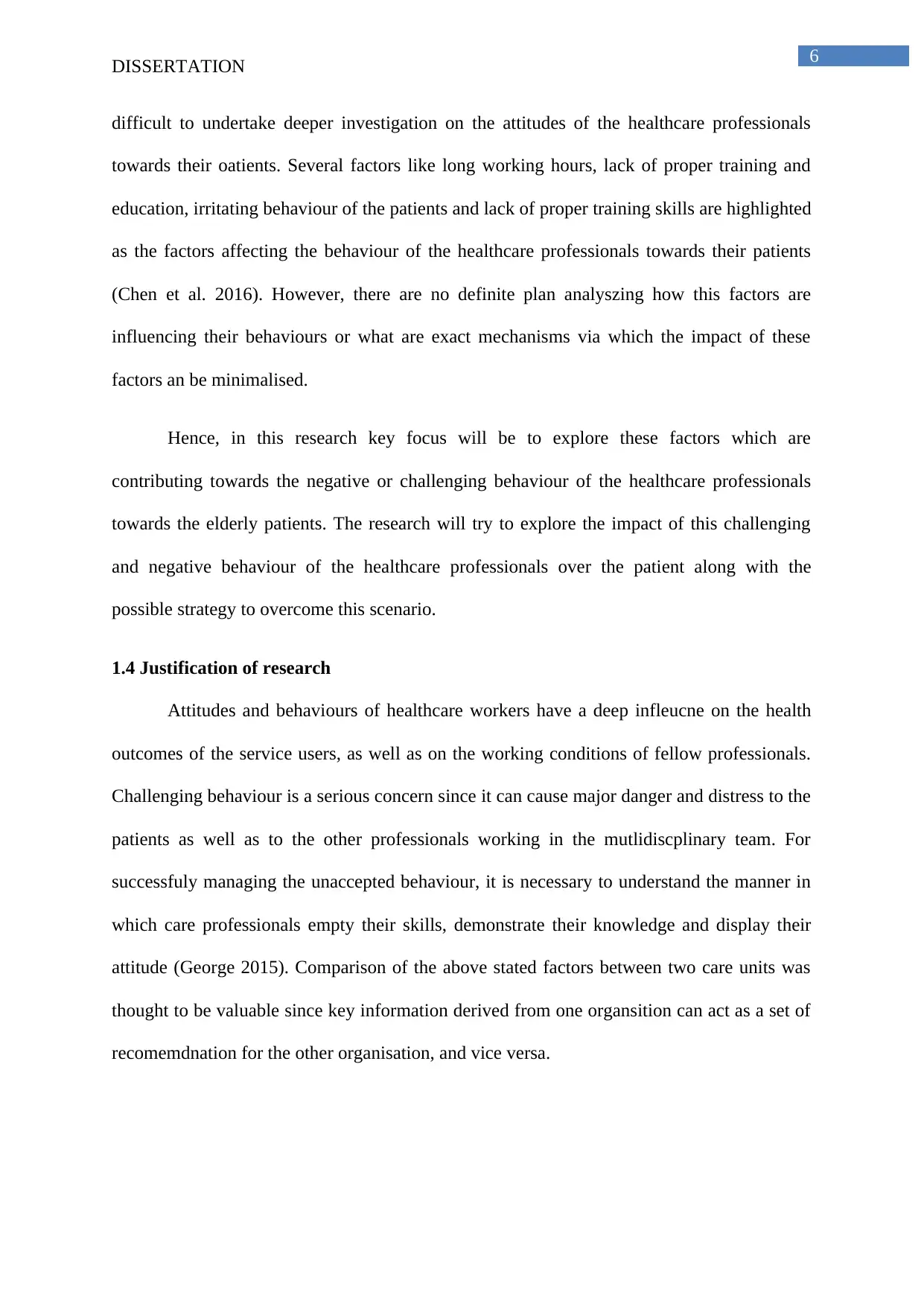
6
DISSERTATION
difficult to undertake deeper investigation on the attitudes of the healthcare professionals
towards their oatients. Several factors like long working hours, lack of proper training and
education, irritating behaviour of the patients and lack of proper training skills are highlighted
as the factors affecting the behaviour of the healthcare professionals towards their patients
(Chen et al. 2016). However, there are no definite plan analyszing how this factors are
influencing their behaviours or what are exact mechanisms via which the impact of these
factors an be minimalised.
Hence, in this research key focus will be to explore these factors which are
contributing towards the negative or challenging behaviour of the healthcare professionals
towards the elderly patients. The research will try to explore the impact of this challenging
and negative behaviour of the healthcare professionals over the patient along with the
possible strategy to overcome this scenario.
1.4 Justification of research
Attitudes and behaviours of healthcare workers have a deep infleucne on the health
outcomes of the service users, as well as on the working conditions of fellow professionals.
Challenging behaviour is a serious concern since it can cause major danger and distress to the
patients as well as to the other professionals working in the mutlidiscplinary team. For
successfuly managing the unaccepted behaviour, it is necessary to understand the manner in
which care professionals empty their skills, demonstrate their knowledge and display their
attitude (George 2015). Comparison of the above stated factors between two care units was
thought to be valuable since key information derived from one organsition can act as a set of
recomemdnation for the other organisation, and vice versa.
DISSERTATION
difficult to undertake deeper investigation on the attitudes of the healthcare professionals
towards their oatients. Several factors like long working hours, lack of proper training and
education, irritating behaviour of the patients and lack of proper training skills are highlighted
as the factors affecting the behaviour of the healthcare professionals towards their patients
(Chen et al. 2016). However, there are no definite plan analyszing how this factors are
influencing their behaviours or what are exact mechanisms via which the impact of these
factors an be minimalised.
Hence, in this research key focus will be to explore these factors which are
contributing towards the negative or challenging behaviour of the healthcare professionals
towards the elderly patients. The research will try to explore the impact of this challenging
and negative behaviour of the healthcare professionals over the patient along with the
possible strategy to overcome this scenario.
1.4 Justification of research
Attitudes and behaviours of healthcare workers have a deep infleucne on the health
outcomes of the service users, as well as on the working conditions of fellow professionals.
Challenging behaviour is a serious concern since it can cause major danger and distress to the
patients as well as to the other professionals working in the mutlidiscplinary team. For
successfuly managing the unaccepted behaviour, it is necessary to understand the manner in
which care professionals empty their skills, demonstrate their knowledge and display their
attitude (George 2015). Comparison of the above stated factors between two care units was
thought to be valuable since key information derived from one organsition can act as a set of
recomemdnation for the other organisation, and vice versa.
⊘ This is a preview!⊘
Do you want full access?
Subscribe today to unlock all pages.

Trusted by 1+ million students worldwide
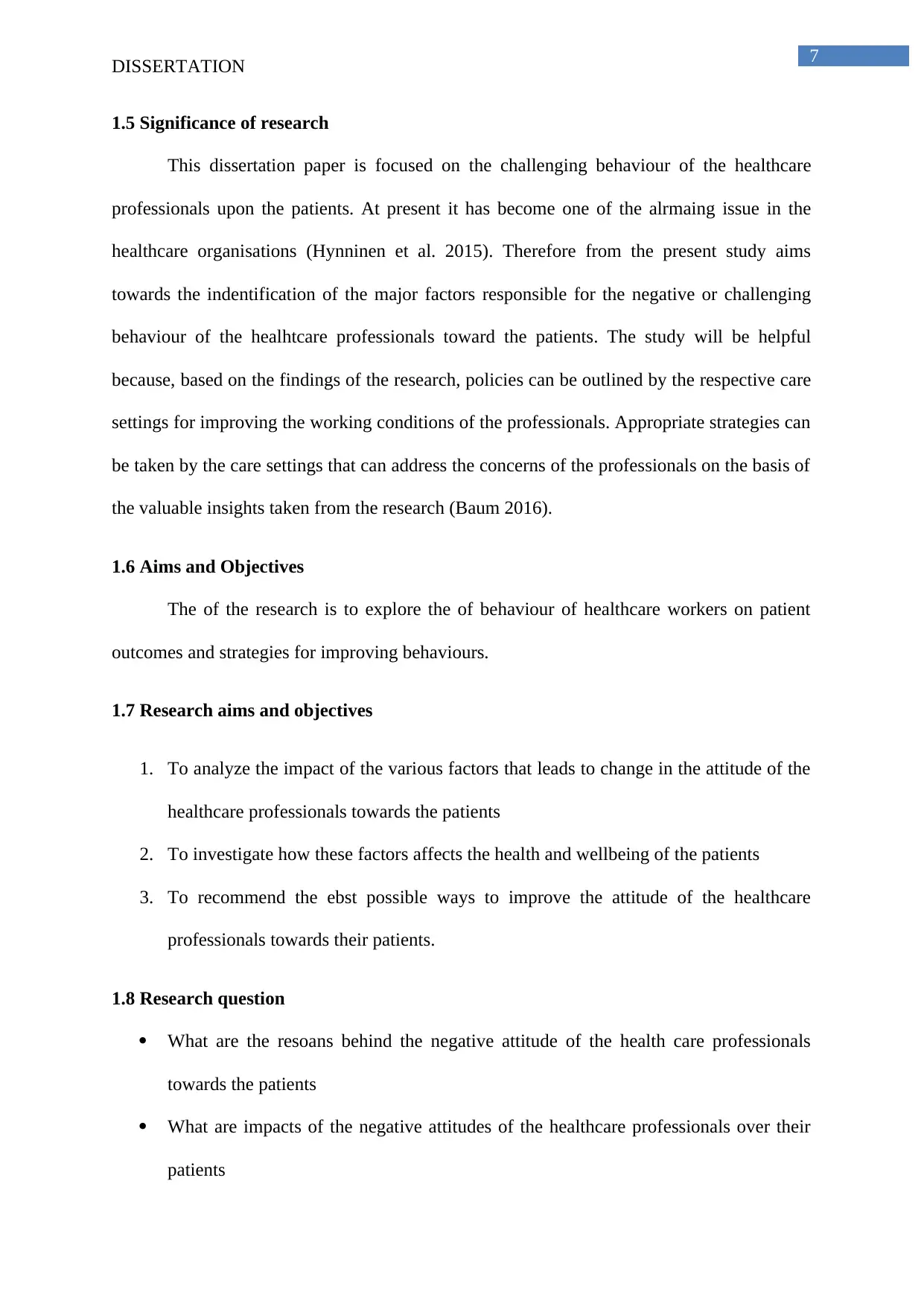
7
DISSERTATION
1.5 Significance of research
This dissertation paper is focused on the challenging behaviour of the healthcare
professionals upon the patients. At present it has become one of the alrmaing issue in the
healthcare organisations (Hynninen et al. 2015). Therefore from the present study aims
towards the indentification of the major factors responsible for the negative or challenging
behaviour of the healhtcare professionals toward the patients. The study will be helpful
because, based on the findings of the research, policies can be outlined by the respective care
settings for improving the working conditions of the professionals. Appropriate strategies can
be taken by the care settings that can address the concerns of the professionals on the basis of
the valuable insights taken from the research (Baum 2016).
1.6 Aims and Objectives
The of the research is to explore the of behaviour of healthcare workers on patient
outcomes and strategies for improving behaviours.
1.7 Research aims and objectives
1. To analyze the impact of the various factors that leads to change in the attitude of the
healthcare professionals towards the patients
2. To investigate how these factors affects the health and wellbeing of the patients
3. To recommend the ebst possible ways to improve the attitude of the healthcare
professionals towards their patients.
1.8 Research question
What are the resoans behind the negative attitude of the health care professionals
towards the patients
What are impacts of the negative attitudes of the healthcare professionals over their
patients
DISSERTATION
1.5 Significance of research
This dissertation paper is focused on the challenging behaviour of the healthcare
professionals upon the patients. At present it has become one of the alrmaing issue in the
healthcare organisations (Hynninen et al. 2015). Therefore from the present study aims
towards the indentification of the major factors responsible for the negative or challenging
behaviour of the healhtcare professionals toward the patients. The study will be helpful
because, based on the findings of the research, policies can be outlined by the respective care
settings for improving the working conditions of the professionals. Appropriate strategies can
be taken by the care settings that can address the concerns of the professionals on the basis of
the valuable insights taken from the research (Baum 2016).
1.6 Aims and Objectives
The of the research is to explore the of behaviour of healthcare workers on patient
outcomes and strategies for improving behaviours.
1.7 Research aims and objectives
1. To analyze the impact of the various factors that leads to change in the attitude of the
healthcare professionals towards the patients
2. To investigate how these factors affects the health and wellbeing of the patients
3. To recommend the ebst possible ways to improve the attitude of the healthcare
professionals towards their patients.
1.8 Research question
What are the resoans behind the negative attitude of the health care professionals
towards the patients
What are impacts of the negative attitudes of the healthcare professionals over their
patients
Paraphrase This Document
Need a fresh take? Get an instant paraphrase of this document with our AI Paraphraser
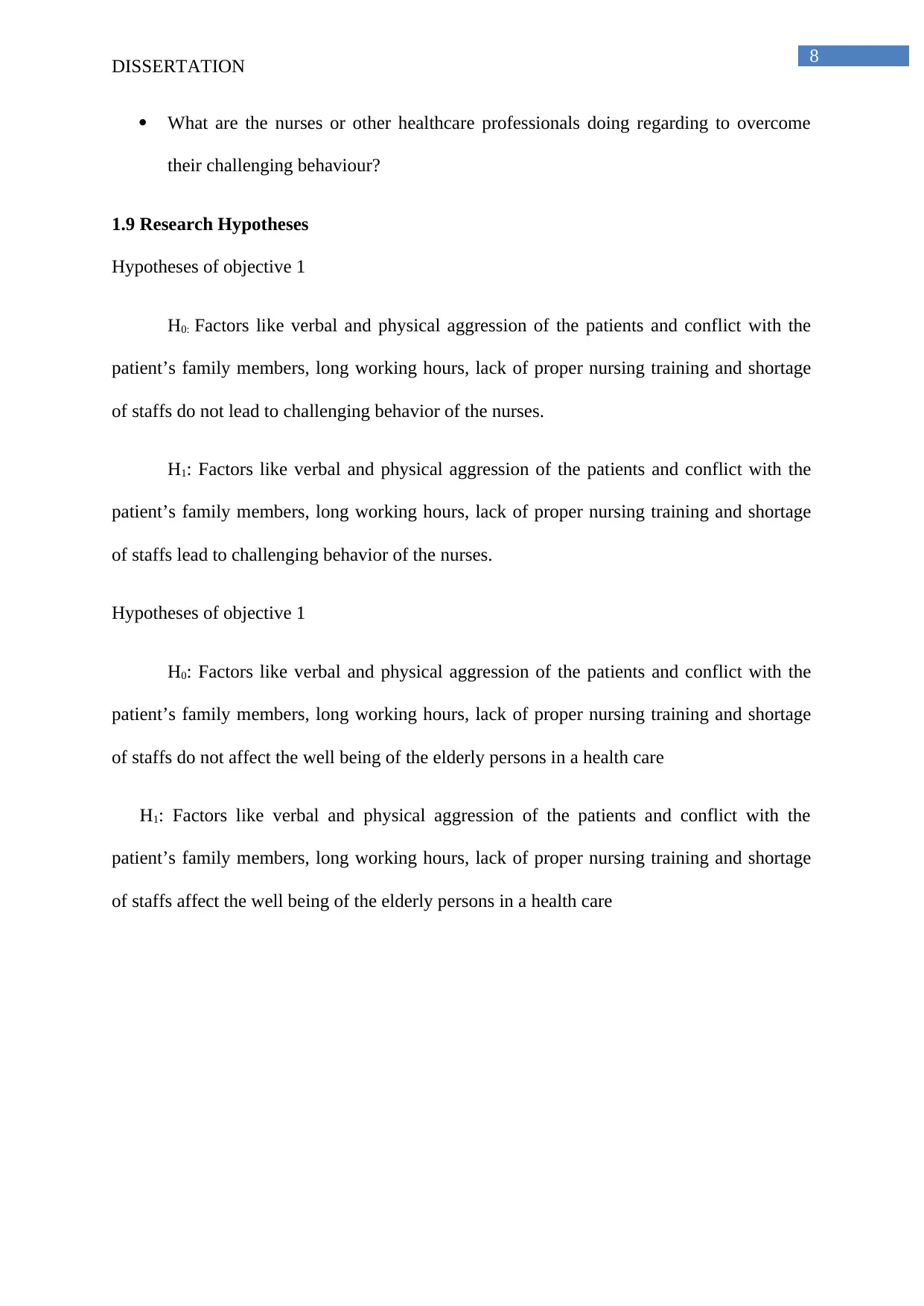
8
DISSERTATION
What are the nurses or other healthcare professionals doing regarding to overcome
their challenging behaviour?
1.9 Research Hypotheses
Hypotheses of objective 1
H0: Factors like verbal and physical aggression of the patients and conflict with the
patient’s family members, long working hours, lack of proper nursing training and shortage
of staffs do not lead to challenging behavior of the nurses.
H1: Factors like verbal and physical aggression of the patients and conflict with the
patient’s family members, long working hours, lack of proper nursing training and shortage
of staffs lead to challenging behavior of the nurses.
Hypotheses of objective 1
H0: Factors like verbal and physical aggression of the patients and conflict with the
patient’s family members, long working hours, lack of proper nursing training and shortage
of staffs do not affect the well being of the elderly persons in a health care
H1: Factors like verbal and physical aggression of the patients and conflict with the
patient’s family members, long working hours, lack of proper nursing training and shortage
of staffs affect the well being of the elderly persons in a health care
DISSERTATION
What are the nurses or other healthcare professionals doing regarding to overcome
their challenging behaviour?
1.9 Research Hypotheses
Hypotheses of objective 1
H0: Factors like verbal and physical aggression of the patients and conflict with the
patient’s family members, long working hours, lack of proper nursing training and shortage
of staffs do not lead to challenging behavior of the nurses.
H1: Factors like verbal and physical aggression of the patients and conflict with the
patient’s family members, long working hours, lack of proper nursing training and shortage
of staffs lead to challenging behavior of the nurses.
Hypotheses of objective 1
H0: Factors like verbal and physical aggression of the patients and conflict with the
patient’s family members, long working hours, lack of proper nursing training and shortage
of staffs do not affect the well being of the elderly persons in a health care
H1: Factors like verbal and physical aggression of the patients and conflict with the
patient’s family members, long working hours, lack of proper nursing training and shortage
of staffs affect the well being of the elderly persons in a health care
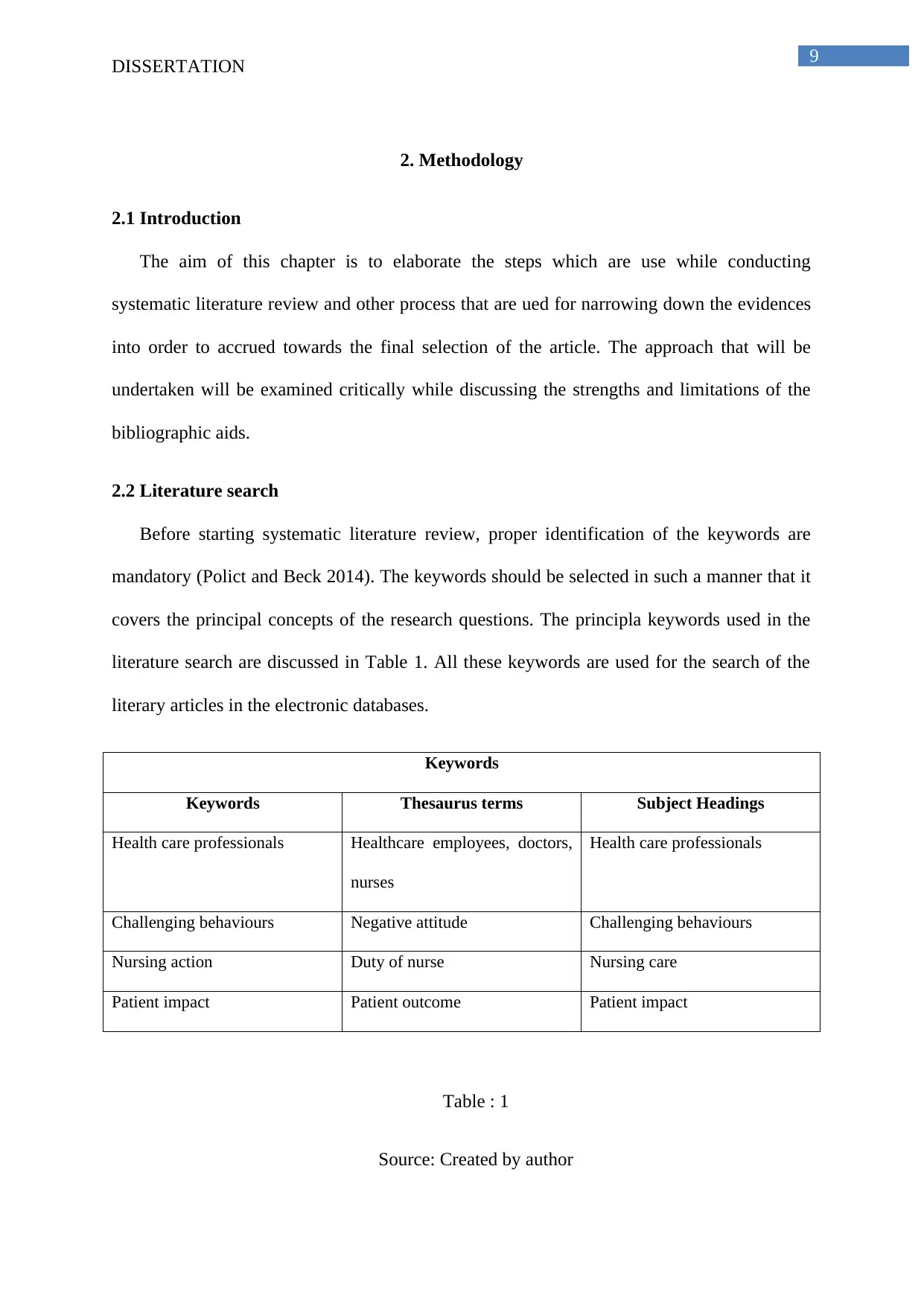
9
DISSERTATION
2. Methodology
2.1 Introduction
The aim of this chapter is to elaborate the steps which are use while conducting
systematic literature review and other process that are ued for narrowing down the evidences
into order to accrued towards the final selection of the article. The approach that will be
undertaken will be examined critically while discussing the strengths and limitations of the
bibliographic aids.
2.2 Literature search
Before starting systematic literature review, proper identification of the keywords are
mandatory (Polict and Beck 2014). The keywords should be selected in such a manner that it
covers the principal concepts of the research questions. The principla keywords used in the
literature search are discussed in Table 1. All these keywords are used for the search of the
literary articles in the electronic databases.
Keywords
Keywords Thesaurus terms Subject Headings
Health care professionals Healthcare employees, doctors,
nurses
Health care professionals
Challenging behaviours Negative attitude Challenging behaviours
Nursing action Duty of nurse Nursing care
Patient impact Patient outcome Patient impact
Table : 1
Source: Created by author
DISSERTATION
2. Methodology
2.1 Introduction
The aim of this chapter is to elaborate the steps which are use while conducting
systematic literature review and other process that are ued for narrowing down the evidences
into order to accrued towards the final selection of the article. The approach that will be
undertaken will be examined critically while discussing the strengths and limitations of the
bibliographic aids.
2.2 Literature search
Before starting systematic literature review, proper identification of the keywords are
mandatory (Polict and Beck 2014). The keywords should be selected in such a manner that it
covers the principal concepts of the research questions. The principla keywords used in the
literature search are discussed in Table 1. All these keywords are used for the search of the
literary articles in the electronic databases.
Keywords
Keywords Thesaurus terms Subject Headings
Health care professionals Healthcare employees, doctors,
nurses
Health care professionals
Challenging behaviours Negative attitude Challenging behaviours
Nursing action Duty of nurse Nursing care
Patient impact Patient outcome Patient impact
Table : 1
Source: Created by author
⊘ This is a preview!⊘
Do you want full access?
Subscribe today to unlock all pages.

Trusted by 1+ million students worldwide
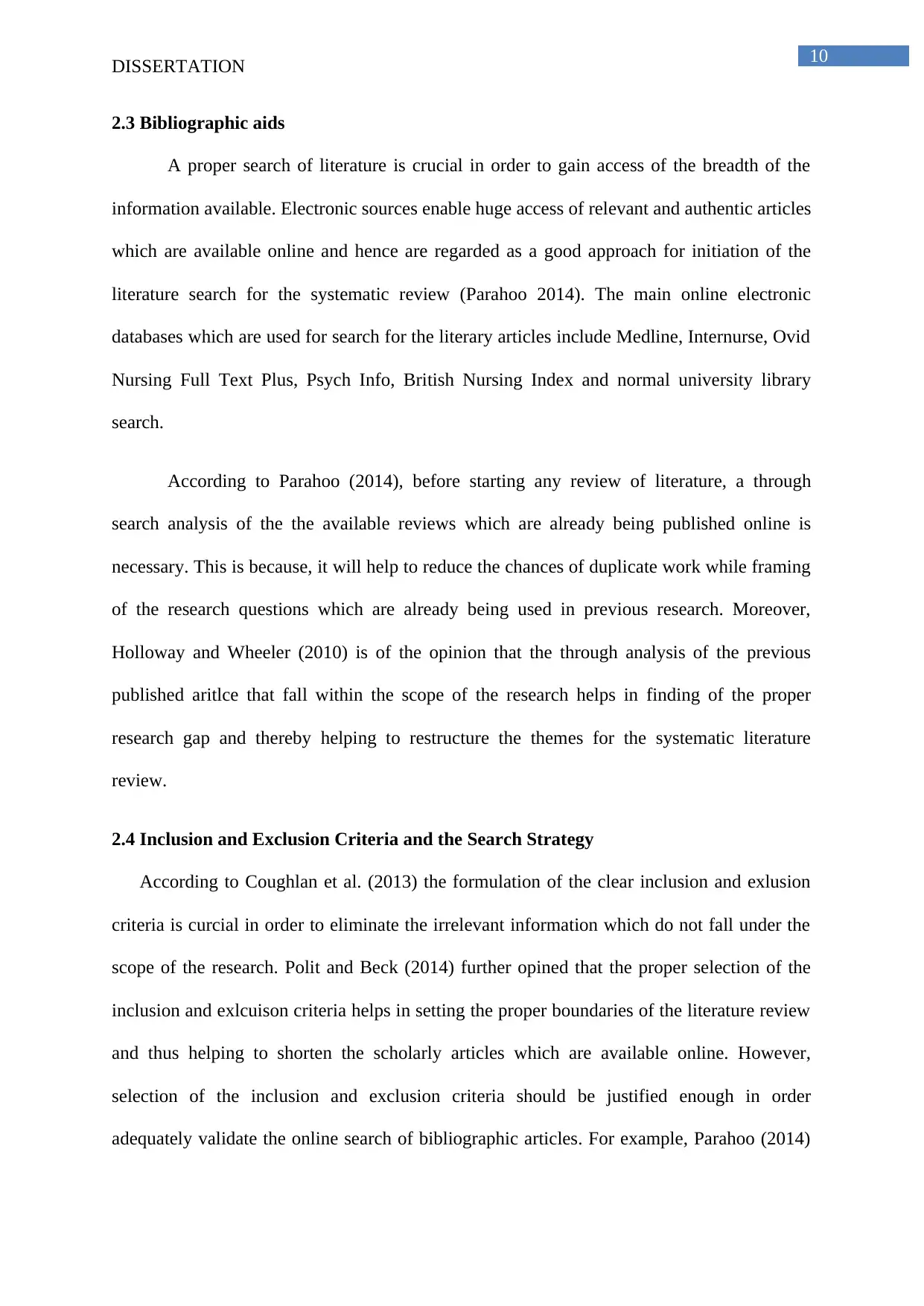
10
DISSERTATION
2.3 Bibliographic aids
A proper search of literature is crucial in order to gain access of the breadth of the
information available. Electronic sources enable huge access of relevant and authentic articles
which are available online and hence are regarded as a good approach for initiation of the
literature search for the systematic review (Parahoo 2014). The main online electronic
databases which are used for search for the literary articles include Medline, Internurse, Ovid
Nursing Full Text Plus, Psych Info, British Nursing Index and normal university library
search.
According to Parahoo (2014), before starting any review of literature, a through
search analysis of the the available reviews which are already being published online is
necessary. This is because, it will help to reduce the chances of duplicate work while framing
of the research questions which are already being used in previous research. Moreover,
Holloway and Wheeler (2010) is of the opinion that the through analysis of the previous
published aritlce that fall within the scope of the research helps in finding of the proper
research gap and thereby helping to restructure the themes for the systematic literature
review.
2.4 Inclusion and Exclusion Criteria and the Search Strategy
According to Coughlan et al. (2013) the formulation of the clear inclusion and exlusion
criteria is curcial in order to eliminate the irrelevant information which do not fall under the
scope of the research. Polit and Beck (2014) further opined that the proper selection of the
inclusion and exlcuison criteria helps in setting the proper boundaries of the literature review
and thus helping to shorten the scholarly articles which are available online. However,
selection of the inclusion and exclusion criteria should be justified enough in order
adequately validate the online search of bibliographic articles. For example, Parahoo (2014)
DISSERTATION
2.3 Bibliographic aids
A proper search of literature is crucial in order to gain access of the breadth of the
information available. Electronic sources enable huge access of relevant and authentic articles
which are available online and hence are regarded as a good approach for initiation of the
literature search for the systematic review (Parahoo 2014). The main online electronic
databases which are used for search for the literary articles include Medline, Internurse, Ovid
Nursing Full Text Plus, Psych Info, British Nursing Index and normal university library
search.
According to Parahoo (2014), before starting any review of literature, a through
search analysis of the the available reviews which are already being published online is
necessary. This is because, it will help to reduce the chances of duplicate work while framing
of the research questions which are already being used in previous research. Moreover,
Holloway and Wheeler (2010) is of the opinion that the through analysis of the previous
published aritlce that fall within the scope of the research helps in finding of the proper
research gap and thereby helping to restructure the themes for the systematic literature
review.
2.4 Inclusion and Exclusion Criteria and the Search Strategy
According to Coughlan et al. (2013) the formulation of the clear inclusion and exlusion
criteria is curcial in order to eliminate the irrelevant information which do not fall under the
scope of the research. Polit and Beck (2014) further opined that the proper selection of the
inclusion and exlcuison criteria helps in setting the proper boundaries of the literature review
and thus helping to shorten the scholarly articles which are available online. However,
selection of the inclusion and exclusion criteria should be justified enough in order
adequately validate the online search of bibliographic articles. For example, Parahoo (2014)
Paraphrase This Document
Need a fresh take? Get an instant paraphrase of this document with our AI Paraphraser
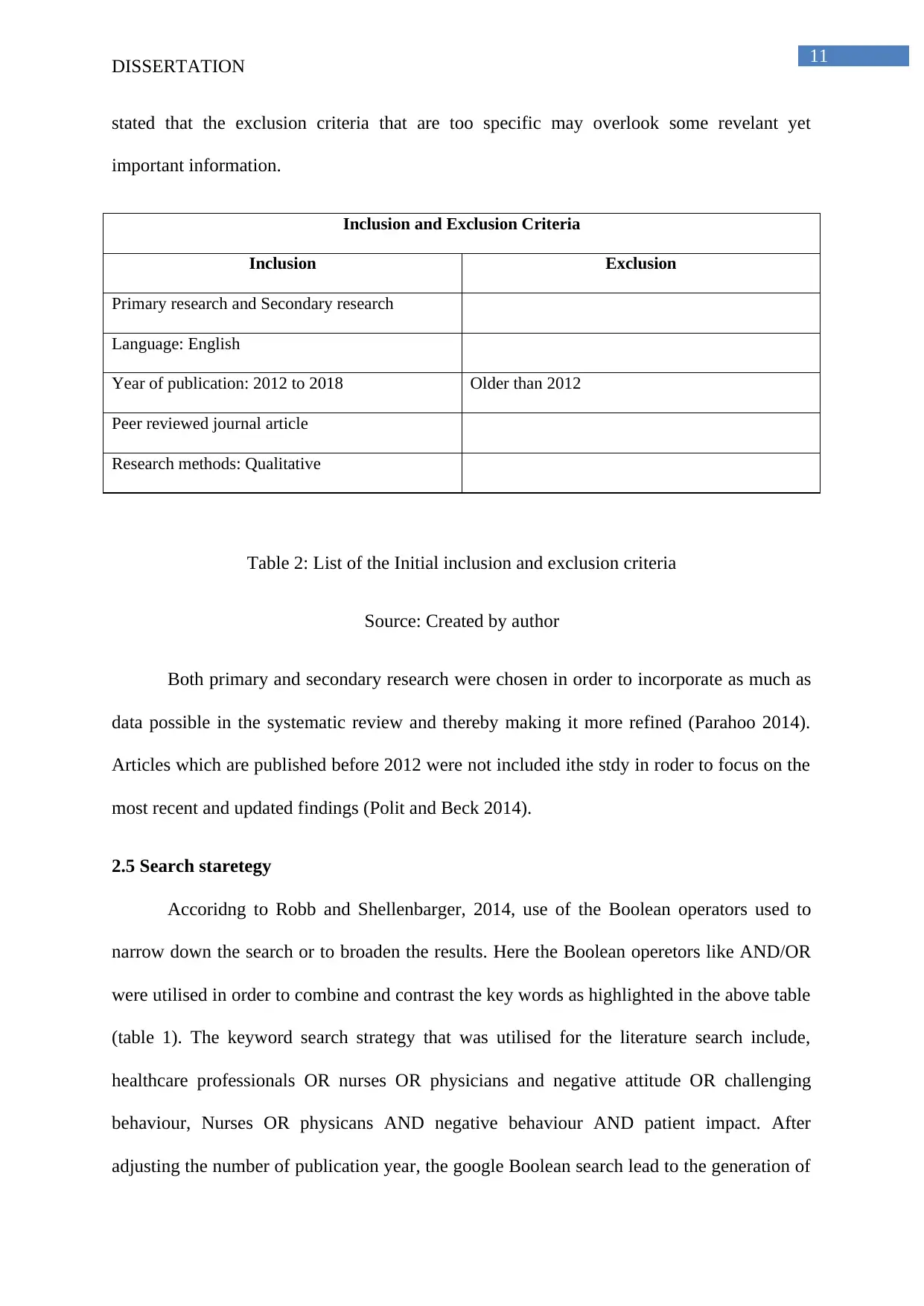
11
DISSERTATION
stated that the exclusion criteria that are too specific may overlook some revelant yet
important information.
Inclusion and Exclusion Criteria
Inclusion Exclusion
Primary research and Secondary research
Language: English
Year of publication: 2012 to 2018 Older than 2012
Peer reviewed journal article
Research methods: Qualitative
Table 2: List of the Initial inclusion and exclusion criteria
Source: Created by author
Both primary and secondary research were chosen in order to incorporate as much as
data possible in the systematic review and thereby making it more refined (Parahoo 2014).
Articles which are published before 2012 were not included ithe stdy in roder to focus on the
most recent and updated findings (Polit and Beck 2014).
2.5 Search staretegy
Accoridng to Robb and Shellenbarger, 2014, use of the Boolean operators used to
narrow down the search or to broaden the results. Here the Boolean operetors like AND/OR
were utilised in order to combine and contrast the key words as highlighted in the above table
(table 1). The keyword search strategy that was utilised for the literature search include,
healthcare professionals OR nurses OR physicians and negative attitude OR challenging
behaviour, Nurses OR physicans AND negative behaviour AND patient impact. After
adjusting the number of publication year, the google Boolean search lead to the generation of
DISSERTATION
stated that the exclusion criteria that are too specific may overlook some revelant yet
important information.
Inclusion and Exclusion Criteria
Inclusion Exclusion
Primary research and Secondary research
Language: English
Year of publication: 2012 to 2018 Older than 2012
Peer reviewed journal article
Research methods: Qualitative
Table 2: List of the Initial inclusion and exclusion criteria
Source: Created by author
Both primary and secondary research were chosen in order to incorporate as much as
data possible in the systematic review and thereby making it more refined (Parahoo 2014).
Articles which are published before 2012 were not included ithe stdy in roder to focus on the
most recent and updated findings (Polit and Beck 2014).
2.5 Search staretegy
Accoridng to Robb and Shellenbarger, 2014, use of the Boolean operators used to
narrow down the search or to broaden the results. Here the Boolean operetors like AND/OR
were utilised in order to combine and contrast the key words as highlighted in the above table
(table 1). The keyword search strategy that was utilised for the literature search include,
healthcare professionals OR nurses OR physicians and negative attitude OR challenging
behaviour, Nurses OR physicans AND negative behaviour AND patient impact. After
adjusting the number of publication year, the google Boolean search lead to the generation of
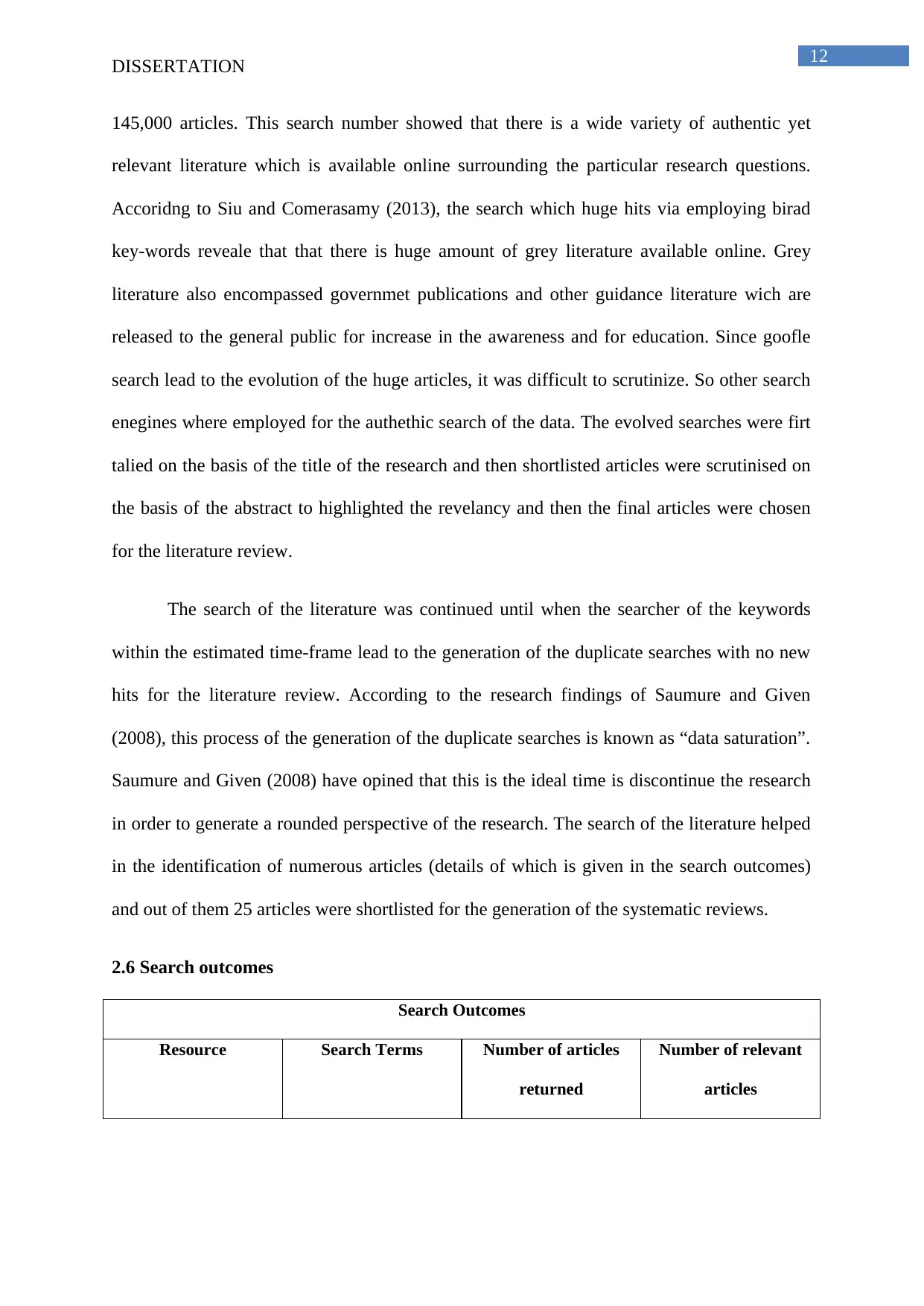
12
DISSERTATION
145,000 articles. This search number showed that there is a wide variety of authentic yet
relevant literature which is available online surrounding the particular research questions.
Accoridng to Siu and Comerasamy (2013), the search which huge hits via employing birad
key-words reveale that that there is huge amount of grey literature available online. Grey
literature also encompassed governmet publications and other guidance literature wich are
released to the general public for increase in the awareness and for education. Since goofle
search lead to the evolution of the huge articles, it was difficult to scrutinize. So other search
enegines where employed for the authethic search of the data. The evolved searches were firt
talied on the basis of the title of the research and then shortlisted articles were scrutinised on
the basis of the abstract to highlighted the revelancy and then the final articles were chosen
for the literature review.
The search of the literature was continued until when the searcher of the keywords
within the estimated time-frame lead to the generation of the duplicate searches with no new
hits for the literature review. According to the research findings of Saumure and Given
(2008), this process of the generation of the duplicate searches is known as “data saturation”.
Saumure and Given (2008) have opined that this is the ideal time is discontinue the research
in order to generate a rounded perspective of the research. The search of the literature helped
in the identification of numerous articles (details of which is given in the search outcomes)
and out of them 25 articles were shortlisted for the generation of the systematic reviews.
2.6 Search outcomes
Search Outcomes
Resource Search Terms Number of articles
returned
Number of relevant
articles
DISSERTATION
145,000 articles. This search number showed that there is a wide variety of authentic yet
relevant literature which is available online surrounding the particular research questions.
Accoridng to Siu and Comerasamy (2013), the search which huge hits via employing birad
key-words reveale that that there is huge amount of grey literature available online. Grey
literature also encompassed governmet publications and other guidance literature wich are
released to the general public for increase in the awareness and for education. Since goofle
search lead to the evolution of the huge articles, it was difficult to scrutinize. So other search
enegines where employed for the authethic search of the data. The evolved searches were firt
talied on the basis of the title of the research and then shortlisted articles were scrutinised on
the basis of the abstract to highlighted the revelancy and then the final articles were chosen
for the literature review.
The search of the literature was continued until when the searcher of the keywords
within the estimated time-frame lead to the generation of the duplicate searches with no new
hits for the literature review. According to the research findings of Saumure and Given
(2008), this process of the generation of the duplicate searches is known as “data saturation”.
Saumure and Given (2008) have opined that this is the ideal time is discontinue the research
in order to generate a rounded perspective of the research. The search of the literature helped
in the identification of numerous articles (details of which is given in the search outcomes)
and out of them 25 articles were shortlisted for the generation of the systematic reviews.
2.6 Search outcomes
Search Outcomes
Resource Search Terms Number of articles
returned
Number of relevant
articles
⊘ This is a preview!⊘
Do you want full access?
Subscribe today to unlock all pages.

Trusted by 1+ million students worldwide
1 out of 37
Related Documents
Your All-in-One AI-Powered Toolkit for Academic Success.
+13062052269
info@desklib.com
Available 24*7 on WhatsApp / Email
![[object Object]](/_next/static/media/star-bottom.7253800d.svg)
Unlock your academic potential
Copyright © 2020–2025 A2Z Services. All Rights Reserved. Developed and managed by ZUCOL.





